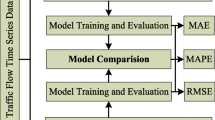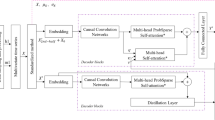Abstract
The pressure of civil aviation traffic is increasing with the prosperity of economy. The accurate forecast of civil aviation flow not only effectively improves the operation efficiency of airlines, but also brings considerable profits to airlines. However, the existing aviation flow forecasting methods generally have the problem of poor forecasting accuracy. Inaccurate traffic prediction models not only fail to bring benefits, but also waste resources of airlines to a certain extent. Therefore, a high-precision forecast of aviation flow is necessary. On the basis of attention mechanism, a high-precision aviation flow model is constructed. First, the deep belief network is used to reduce the dimension of the data. Then, the Gated Recurrent Unit model is used to extract the time series features of the reduced dimension data. Finally, the attention mechanism is used to preserve the key features to achieve high-precision prediction. By analyzing historical data, the model which we proposed can accurately perceive the evolution process of civil aviation traffic and realize the high-precision prediction of short-term passenger flow. Experimental results show that the prediction accuracy of the model in this paper is significantly higher than other existing models, and the application of this model will bring considerable benefits to airlines.







Similar content being viewed by others
References
Donovan AW. Yield management in the airline industry. J Aviat Aerosp Educ Res. 2005;14(3):9.
Pak K, Piersma N. Airline revenue management: an overview of OR techniques 1982–2001. 2002.
Pitfield DE. Predicting air-transport demand. Environ Plan A. 1993;25(4):459–66.
Tang X, Deng G. Prediction of civil aviation passenger transportation based on ARIMA model. Open J Stat. 2016;6(5):824–34.
Etzioni O, Tuchinda R, Knoblock CA, Yates A. To buy or not to buy: mining airfare data to minimize ticket purchase price. In: Proceedings of the ninth ACM SIGKDD international conference on Knowledge discovery and data mining. 2003. p. 119–28.
Weatherford LR, Gentry TW, Wilamowski B. Neural network forecasting for airlines: a comparative analysis. J Revenue Pricing Manag. 2003;1(4):319–31.
Wei Y, Chen MC. Forecasting the short-term metro passenger flow with empirical mode decomposition and neural networks. Transp Res Part C Emerg Technol. 2012;21(1):148–62.
Jiang X, Chen X, Zhang L, Zhang R. Dynamic demand forecasting and ticket assignment for high-speed rail revenue management in China. Transp Res Rec. 2015;2475(1):37–45.
Xie G, Wang S, Lai KK. Air passenger forecasting by using a hybrid seasonal decomposition and least squares support vector regression approach. In: Proceedings of the 59th world statistics congress of the international statistical institute. Hong Kong; 2013.
Chen R, Liang CY, Hong WC, Gu DX. Forecasting holiday daily tourist flow based on seasonal support vector regression with adaptive genetic algorithm. Appl Soft Comput. 2015;26:435–43.
Cheng A, Jiang X, Li Y, Zhang C, Zhu H. Multiple sources and multiple measures based traffic flow prediction using the chaos theory and support vector regression method. Phys A Stat Mech Appl. 2017;466:422–34.
Hu W, Yan L, Liu K, Wang H. A short-term traffic flow forecasting method based on the hybrid PSO-SVR. Neural Process Lett. 2016;43(1):155–72.
Paparrizos J, Gravano L. Fast and accurate time-series clustering. ACM Trans Database Syst (TODS). 2017;42(2):1–49.
Yuan K, Wei B. Network traffic prediction based on phase space reconstruction and ELM. Control Eng. 2018;25(11):2087–91.
Xu H, Wang M, Jiang S, Yang W. Carbon price forecasting with complex network and extreme learning machine. Phys A Stat Mech Appl. 2020;545:122830.
Xie J, Li T, Yang Y, Jin W. Learning features from high speed train vibration signals with deep belief networks. In: 2014 International Joint Conference on Neural Networks (IJCNN). IEEE; 2014. p. 2205–10.
Bengio Y, Lamblin P, Popovici D, Larochelle H. Greedy layer-wise training of deep networks. In: Advances in neural information processing systems. 2007. p. 153–60.
Dey R, Salem FM. Gate-variants of gated recurrent unit (GRU) neural networks. In: 2017 IEEE 60th international midwest symposium on circuits and systems (MWSCAS). IEEE; 2017. p. 1597–600.
Athiwaratkun B, Stokes JW. Malware classification with LSTM and GRU language models and a character-level CNN. In: 2017 IEEE International Conference on Acoustics, Speech and Signal Processing (ICASSP). IEEE; 2017. p. 2482–6.
Vaswani A, Shazeer N, Parmar N, Uszkoreit J, Jones L, Gomez AN, Kaiser Ł, Polosukhin I. Attention is all you need. In: Advances in neural information processing systems. 2017. p. 5998–6008.
Acknowledgements
All the content was written by the author.
Author information
Authors and Affiliations
Contributions
The author contributed to the conception and design of the study. Material preparation, data collection, and analysis were carried out by Jiangni Yu. The original manuscript was written by Jiangni Yu, and all the papers have been written and revised by Jiangni Yu.
Corresponding author
Ethics declarations
Ethics Approval
This article does not contain any studies with human participants or animals performed by any of the authors.
Conflict of Interest
The author declares no competing interests.
Additional information
Publisher's Note
Springer Nature remains neutral with regard to jurisdictional claims in published maps and institutional affiliations.
Rights and permissions
About this article
Cite this article
Yu, J. Short-term Airline Passenger Flow Prediction Based on the Attention Mechanism and Gated Recurrent Unit Model. Cogn Comput 14, 693–701 (2022). https://doi.org/10.1007/s12559-021-09991-x
Received:
Accepted:
Published:
Issue Date:
DOI: https://doi.org/10.1007/s12559-021-09991-x




